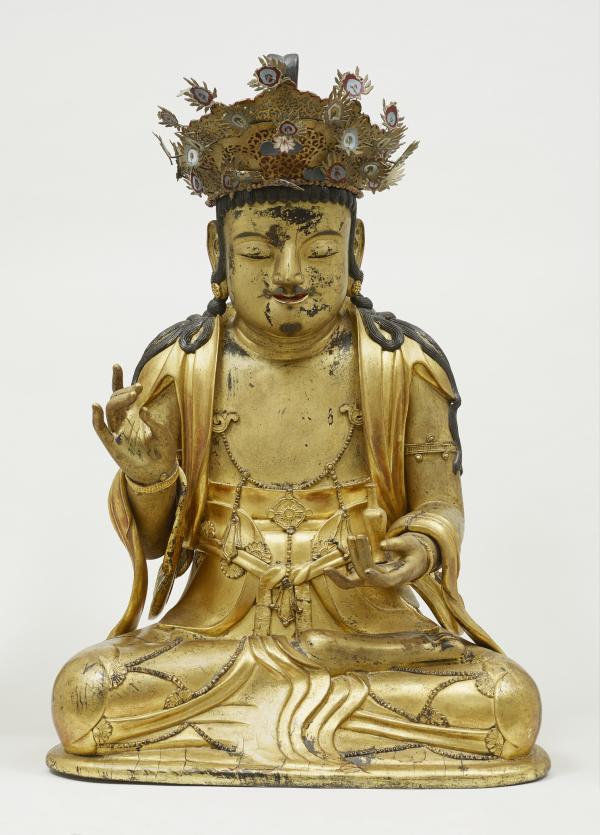In the form of Buddhism known as Mahayana (“Great Vehicle”), which developed in India some two thousand years ago, there was, in addition to the historical Buddha Shakyamuni who lived circa 600 BCE, a system of Five Cosmic Buddhas believed to rule over the four cardinal directions and the center of space. These cosmic Buddhas each have emanations known as bodhisattvas: spiritual beings who attained enlightenment like Buddha, but, rather than entering into the void of Nirvana, take a vow to maintain their presence in the phenomenal world to help all other sentient beings attain enlightenment.
This rare Korean gilt wood sculpture depicts one of the greatest of these bodhisattvas: Mahasthamaprapta (known in Korean as Daeseji), symbolizing the power of wisdom in Buddhist practice, and identifiable by the vase held in the left hand. In Buddhist art Mahasthamaprapta is usually shown as part of a triad, along with the Buddha Amitabha (Buddha of the western quadrant of space) and Avalokiteshvara, Bodhisattva of Compassion. Mahasthamaprapta was one of the first bodhisattvas mentioned in early Indian Buddhist texts (sutras), and eventually became a widely worshipped figure, especially in East Asia (China, Korea, and Japan).
Aside from the historical Buddha Shakyamuni, the most popular Buddha in East Asia was Amitabha, Buddha of the Western Paradise, or Pure Land. As spiritual emanations of Amitabha, the bodhisattvas Avalokiteshvara and Mahasthamaprapta are both worshipped by devotees of the Pure Land sect, who believe that entry into paradise could come about through recitation of the Buddha Amitabha’s name. As a result, both sculpted and painted images of Mahasthamaprapta became important in the practice of Pure Land Buddhism, beginning in China by the Six Dynasties Period (386–589).
Buddhism arrived in Korea in the fourth century CE, with the arrival of monks from India and China. The foreign religion, which taught a means to transcend life’s inevitable suffering and the cycle of birth, life, death, and rebirth, quickly took hold and was soon supported by the royal families of the Three Kingdoms Period. From this time onward Buddhism enjoyed widespread patronage and flourished throughout the Korean peninsula. Even though state sponsorship of Buddhism waned during the Joseon dynasty (1392–1910), private patronage of Buddhist art continued to thrive, resulting in many beautiful works such as this sculpture.
This magnificent sculpture, beautifully carved in wood and covered with coats of lacquer and gilding, can be dated to the 17th century by comparison with similar examples in Korean collections. This rare sculpture of Bodhisattva Mahasthamaprapta provides LACMA a wonderful opportunity to develop its permanent collection of Korean Buddhist art, and to further consolidate the museum’s position as an international leader in the presentation of Korean art and culture.
During our 32nd annual Collectors Committee Weekend (April 20–21), members of LACMA's Collectors Committee generously helped the museum acquire 10 works of art spanning a breadth of eras and cultures. Check back tomorrow to learn about another acquisition.



